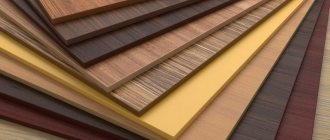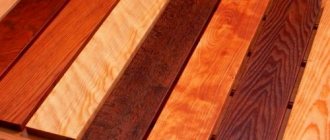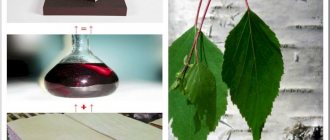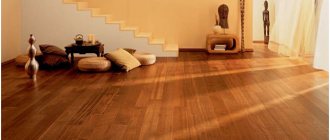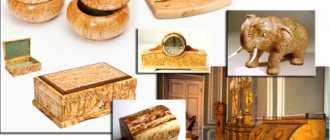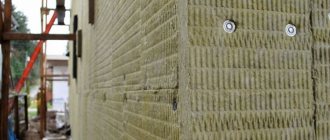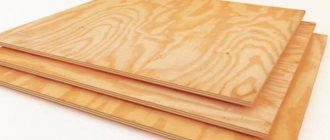Part of the room where the walls are decorated with MDF panels
The production of MDF wall panels is similar to the production of fiberboard, however, the difference lies in the use of the structure of the base material, which affected the distinctive properties of MDF panels. If in the production of fiberboard, chips were used, compressed under high pressure and with the addition of adhesive components, then for the production of MDF panels, wood dust is used, which is also compressed under high pressure, but in a vacuum. The substance lignin is used as a binding element for MDF, which firmly glues small wood chips.
Characteristics and scope of MDF
Over time, more and more different materials appear, and manufacturers are constantly striving to improve their characteristics. However, for many centuries, wood has been popular with builders and furniture makers. It was this that, in the first stages of human development, was the fuel for the hearth and provided heat, made it possible to build a home, cut out household utensils necessary for storing and preparing food.
Thousands of years have passed, and wood has been and remains one of the most sought-after materials. Millions of hectares of forests are still being cut down to obtain lumber. It is noteworthy that manufacturers did not immediately come to use raw materials in full, as well as their processed products. However, about a century ago, the idea of using wood chips and shavings remaining after sawing tree trunks came to the minds of the owners of forestry enterprises. As a result of the search for ways to use wood waste, fiberboard and chipboard were created, and then a more advanced sheet building material, MDF, appeared. In terms of their technical characteristics, they were in no way inferior to industrial wood, and in some ways even surpassed it.
Where is it used?
It is considered the best alternative to many finishing materials, therefore it is widely used in many areas. Its decorative boards are used for the production of furniture, especially the unforgettable facades of cabinets in the kitchen, children's room, hallway and living room. In the automotive industry, they are used to trim parts in car interiors. Construction companies use MDF for repairs and finishing of floors and walls. It is also used for the manufacture of various containers. This material makes excellent doors and door frames, as well as wall partitions. You can find out what MDF plinth is from our article.
MDF is used in the advertising business - exhibition stands are made from it. In electronics, it has found application in the production of speakers and other acoustic systems.
As part of the topic, it is useful to read about what fiberboard is.
MDF is a decorative material that has found application in various industries. It adequately replaces wood and at the same time costs half as much. It is not inferior to it in quality, and in some characteristics it far exceeds the indicators. In order not to get confused in concepts, it is also worth finding out what HDF is and whether it is suitable for your work. It is the best option for those who want to carry out repairs or assemble furniture using high-quality materials, without prohibitive costs.
History of the creation of MDF
MDF was invented in 1924. It was then that the American William Mason, by pure chance, received a slab not from shavings, as was previously the case, but from wood fibers. Having noticed tons of waste around wood processing factories and factories, he decided to find a practical use for it. He believed that from waste wood chips, shavings and sawdust it would be possible to make something similar to a sheet of plywood. At some point, he even hoped to make paper from wood waste.
First, Mason created a device that vaguely resembled a machine. Later it received an unofficial name - “Mason's gun”. The mechanism consisted of a steel pipe, closed on one side and complemented by a cover that could be removed. On the other hand, there was also the possibility of opening, but at a distance. Chips, shavings and sawdust were placed into the pipe, and then water was poured in a certain amount. Next, it was necessary to create pressure, for which Mason used a gas burner. As a result, the wood fibers disintegrated into smaller particles and were transported through the gun barrel into a special container.
However, it would not have been possible to make paper from such raw materials, which the inventor initially thought about, since the wood elements remained too large. The next stage was the creation of a building slab. Mason places the already processed sawmill waste into a steam press, but after that, events do not unfold at all according to the planned scenario. Firstly, the machine turned out to be faulty: the inventor did not see that the valve was leaking in the steam press, and the steam was entering the “cushion” of wood fibers located between the tamping plates. Secondly, Mason was supposed to turn off the mechanism by lunchtime, but forgot about it, so the wood continued to be processed.
Thus, the sawmill waste was compressed by a press for several hours and at the same time doused with steam. When the American discovered his mistake, he was sure that all his efforts were in vain, but it turned out differently. When he removed the press, he saw that the slab had gained rigidity and became surprisingly smooth. The inventor called the wood fiber board obtained completely by accident “masonite”. It was many times worse than modern hardboard, however, it subsequently began to change, which made it possible to significantly improve the characteristics of the material.
Mass production of MDF began in 1966 in the USA. It received its now known abbreviated name from English – “medium density fiberboard”. It is impossible to say for sure who became the inventor of the modern MDF board, since dozens of companies in the country worked on its development.
In the Soviet Union, such material was not produced at all. The first MDF manufacturing plant in Russia appeared only in 1997; it was built in the Vologda region, in the village of Sheksna. Nowadays, most MDF is supplied to the market by China, which is recognized as the world producer of this material.
Installation methods
Installation of panels does not require special skills. Installation conditions depend only on the method of its implementation.
On the frame
The frame method is used for large uneven walls; in wet rooms, galvanized guides should be chosen. This method allows for additional insulation and soundproofing of the room.
Frame mounting is used for uneven walls.
On glue
Installation using glue is carried out in rooms where space needs to be preserved. It is first necessary to level the surface, remove roughness, and seal cracks. After preparation, the wall is treated with a primer. Then glue is applied pointwise to the back side of the tile.
The panel with the composition is placed on the wall and held for several seconds, pressed tightly to the surface.
MDF production technology
In the 50s of the 20th century, fiberboards were processed using the so-called “wet method”. In some ways, this technology is similar to that used to produce cardboard. Now all manufacturers implement the “dry method” on their lines. It involves several stages:
- wood preparation;
- grinding raw materials into fibers;
- carpet making, pressing and sawing of fabric;
- grinding work.
Preparation of raw materials. The main material for the production of MDF is round timber. Completely different types of wood can be used. First, the trunks are placed in drum machines, where their primary processing occurs: the bark is removed. The next step is to chop the wood into chips; special disintegrator machines are used for this. As a result, the material is not only crushed, but its very structure is destroyed: fibers bound together by lignin (a natural polymer present in tree trunks) are broken down. The processed wood chips are unloaded onto a belt, where any metal elements that accidentally fall in are removed using a magnet. The next step is sorting into 3 fractions using vibrating screens.
Chips that are too large in size are re-cut in a disintegrator, and chips that are too small cannot be processed at all and are burned in the boiler room. The raw materials of the required size are collected and sent to vertical cyclones. Here, mineral impurities and all kinds of debris are removed by leaching. Next, the wood chips are sent to a steam installation, where the material is heated to 100 °C and a humidity of more than 80% is achieved.
Production of wood fibers. At the next stage, a special defibrator machine is used, also known by another name - a refinator. It is necessary to transport wood chips moistened and heated to the required temperature here. The feed material, pushed forward by the movement of the screw feeder, enters the gap between the conical and disc blades. Here the wood is divided into fibers. In some cases, the raw material goes through the procedure more than once; the process can be repeated up to 3 times until the desired state of the fibers is achieved.
In addition to targeted processing in a defibrator, the characteristics of chips are also improved through the use of various additives. For these purposes, the following are used: resins, paraffin, binders, hardeners.
Note. There is no need to compare the procedure for obtaining wood fibers and making flour. If it is necessary to obtain wood flour, the manufacturer grinds the raw materials to obtain the material of the desired fraction, but of a non-uniform shape. In the production of fiberboard, the goal is to produce wood fiber of natural structure, length and size.
While the fibers enter the dryer, a jet of steam is directed at them, which helps maintain their humidity and temperature. In the drum where the raw material ends up, it is blasted with hot air (temperature 170-240 °C) for 5 seconds. In the cyclone mechanism, air is extracted from the resulting dried mass, and then the material is sent to a storage hopper, then to molding.
Carpet preparation and pressing. At the next stage, the manufacturer is faced with the task of creating a carpet from fibers. Manufacturing is carried out on a conveyor with a roller mechanism. The fabric is pressed and weighed, and air is removed from the space between the fibers. Afterwards, the carpet goes back under the press, where finishing formation is carried out.
The manufactured slabs must be cut into the material of the required size, and at the end they are cooled with a stream of air.
Grinding. In order for MDF boards to be perfectly smooth, which is not always possible to achieve after pressing, they are additionally sanded. As a result, it is possible to obtain slabs with a uniform surface, the same thickness and without visible defects. Before placing MDF in the warehouse, they are marked and can also be sent for additional processing, which involves decorating the surface.
Step-by-step instruction
Installation of sheets is glue-based and does not require much time. Cladding walls onto a frame is a more labor-intensive process, but even an inexperienced craftsman can handle it by following simple recommendations.
Preparatory activities
Before installation on the frame, a special structure must be installed. The lathing is made of a metal profile or wooden beam (side length 30 mm and humidity no more than 15%). Before installation, the wood is treated with a bioprotective impregnation.
To carry out the work you will need the following tools: tape measure, level, electric jigsaw or hacksaw, screwdriver, hammer or stapler.
To carry out the work you will need an electric jigsaw.
Installation of guides depends on the location of the panels. In the case of vertical installation, the sheathing elements are attached horizontally to the wall, i.e. perpendicular to the canvas. In other orientations, the installation is carried out in reverse.
Execution of work
Work order.
- Measuring and marking the wall (distance between guides 50-60 cm).
- Attaching the profile to the surface. The first rail is installed at the junction of 2 walls. It is attached to a concrete or brick surface using dowels, and to a wooden surface with self-tapping screws.
- Between the frame elements, additional wall insulation is made, for example, mineral wool is laid.
- The starting panel is mounted in a corner and secured with self-tapping screws to the guide. On the opposite side, clamps are inserted into the groove at the intersection with the slats and secured with nails or staples.
- The tenon of the next lining is driven into the groove of the previous one and fixed with clamps.
- The last sheet is cut so that it fits freely into the groove of the previous one and there is a gap of 5 mm to the wall. Complete the fixation with a self-tapping screw.
Types of MDF finishing
Most often, for decorative purposes, 3 types of MDF coating are used: painting, veneering and lamination.
Veneering. A thin slice of wood is glued to the surface of the finished MDF. Valuable and rare breeds are usually used. When you first examine such products, you can see that they are practically no different visually from natural wood. In addition, they are considered more resistant to negative environmental factors: they are not afraid of dampness and temperature changes. Over time, such materials do not crack or warp.
Lamination. Another technology based on gluing an additional layer to the outer surface of the MDF board. Only, unlike veneering, when laminating, an artificial film made of polyvinyl chloride is used. It has its advantages. One of them is the variety of textures and colors. As a result, you can get a product that looks like stone, wood or other material. Manufacturing using lamination of glossy or matte MDF is also considered popular. The PVC base is attached to the surface of the slab under a press, and formaldehyde resin acts as a fastening agent. As a result, the manufacturer can offer the buyer MDF with a long service life, resistant to abrasion, loss of color and brightness, and unable to accumulate a static charge.
Coloring. When coating MDF with enamels and paints, compositions are selected that are characterized by good fluidity and elasticity. Painting is used to improve the characteristics of MDF: it becomes resistant to mechanical damage, dampness, chemical elements, and chips. Typically, the procedure includes not only the application of enamels or paints, but also pre-treatment: puttying and primer.
What are MDF panels
To the question: “What is it – MDF panels?”, experts answer – medium-density fiber boards. The material has a thickness of three to six mm, consists of very small shavings, sawdust, “bound” using modified urea resins and lignin. From such wood waste, sheets, long narrow panels, and rectangular tiles are created using the dry pressing method. The product is covered with a film on top, most often imitating the texture of wood. MDF can be painted; it is covered with veneer of valuable and ordinary wood species, making it practically indistinguishable from real wood in appearance.
MDF (fine fraction) is made from tiny wood particles that are formed into a board by pressing.
Characteristics of MDF
There are no GOST standards for medium-density fiberboards in the Russian Federation. As a result, manufacturers manufacture products either according to specifications (technical specifications) or supply products that comply with the European standard ANSI A208.2.
By grade, MDF boards are divided into boards of the first and second grade, and their thickness can vary from 6 to 24 mm. The joining of wood fibers in a carpet can be carried out through the use of a natural polymer - lignin or urea-formaldehyde resins. There are a number of companies that bond only with lignin, which later gives them the opportunity to claim the environmental safety of their products. In reality this is not the case.
MDF is supplied to the market in standard sizes:
- 1650*1650 mm;
- 2800*1650 mm;
- 2750*1650 mm;
- 2250*1650 mm;
- 2440*1650 mm.
There are also products of other sizes, but also the same in width:
- 3660*1650 mm;
- 3050*1650 mm;
- 2100*1650 mm;
- 1850*1650 mm.
By grade, MDF boards are divided into:
- Grade I - smooth, homogeneous products with a uniform structure, there are no roughness, chips, scratches, or foreign elements on their surface;
- Grade II – products with minor defects: gouges and scratches up to 0.03 mm deep and no more than 20 mm long are allowed, minor chips on the edge, uneven spot grinding are possible;
- Grade III - products with pronounced defects, scratches and damage are visible on the surface, there is no smoothness, there may be chips along the edges; This material is suitable primarily for construction purposes.
The density of MDF boards produced today ranges from 600 to 1200 kg/m3. The release of free formaldehyde per 100 g of mass is allowed - E1, that is, not higher than 10 mg.
The moisture resistance of MDF boards is directly related to the thickness of the product. Panels of thinner thickness are deformed to a greater extent. Plates with a cross section of 6-8 mm swell by approximately 17% of their original volume.
By using additional processing methods, the technical characteristics of MDF boards can be improved. Thus, it is possible to achieve greater moisture resistance, non-flammability, and greater resistance to fungi and mold.
Legend
The consumer should obtain the maximum amount of information directly from the designation of the slabs. State regulations require mandatory indication of information about the brand, quality group, grade, linear parameters and standard for a specific type of slab. All data is printed on the reverse side of the sheet. Additionally, consumers can demand a quality certificate from the manufacturer, but such rights are given only to wholesale buyers.
Brands and varieties
Advantages and disadvantages of MDF
Advantages of MDF. The advantages of fiberboards include:
- Moisture resistance. The slabs are characterized by increased density and uniformity due to compressed wood fibers. The presence of lamination, veneer or a decorative layer of paint increases the performance characteristics of the product. As a result, it is not afraid of water and can be wiped with a damp cloth. However, even with additional finishing, manufacturers do not recommend using MDF in rooms where there is a constant high level of humidity. In this case, waterproof slab models are purchased.
- Strength. Modern MDF products are comparable in strength to ordinary wood, and their properties are better than chipboard. The characteristics acquired during the production process allow the slabs to be used to create decorative and functional products.
- Affordable price. As mentioned above, MDF is practically no different from natural wood, but the price of the panels is much lower. Thus, laminated MDF boards 16 mm thick will cost the buyer about 300 rubles. per m2.
- Long service life. Due to the fact that the panels are able to withstand sudden temperature changes, they do not deform or break. Additional impregnation with special compounds allows you to avoid the appearance of fungus, mold, and damage to the product by insects or rodents. MDF does not require regular maintenance - painting or varnishing. If the owner follows the manufacturer's recommendations when using items made from fiberboard, they will last more than 10 years.
- Wide possibilities for decoration. There are already many ways to finish MDF, and combining them is acceptable. All this allows you to create not only functional objects, but also visually attractive and even unusual ones.
- Ease of operation. When making products from MDF or installing boards, there is no need to have special education or expensive tools. If during assembly or operation one of the fragments is damaged, it is easy to replace it, since the panels are supplied in standard sizes.
- Possibility of creating relief. MDF is quite smooth and dense, which allows for additional milling to obtain the desired pattern.
Disadvantages of fiberboard:
- Product weight. With the same dimensions of wood and MDF, the latter will be much heavier.
- Dust during processing. It is impossible to saw or sand a slab without causing a lot of debris and dust. It is recommended to wear a respirator.
- Difficulty in working with fasteners. If you need to drive a nail or screw a screw into a slab, you will first have to drill a hole, and only then take on other building materials.
- Low load-bearing strength. Assembling tall vertical structures from MDF would be a bad idea, since during operation they are unreliable and can collapse under their own weight.
- Low environmental safety indicators. MDF manufacturers often claim that their products do not emit toxic substances and are completely harmless. Such statements about complete environmental friendliness are somewhat exaggerated. In reality, the emission class of the boards is low and close to natural wood, but the emission of formaldehyde cannot be denied.
dimensions
Depending on the area of application of MDF, the dimensions of the facing material also change. Here you can derive the following standards:
- Wall panels. The standard length of the wall panel is 2.62 meters, however, some manufacturers produce products with lengths 2.44 and 2.8 m. Width may vary within 100-900 mm. Panels are divided into types depending on width P-1, P-2, P-3, P-4, P-5 (100, 125, 150, 175, 250). With panel thickness 3-30 mm. The thickness of veneered MDF can reach 60 mm.
Compliance with quality requirements:Specific resistance during normal coating separation. MPa, not less 0,4 Coating abrasion resistance, rpm, not less 30 Hardness of protective and decorative coating, microns. no more 120 Warping, µm/m, no more 1.5 - Plates . The length of the material is usually about 1.5 meters , width - 100-900 mm . The thickness of MDF boards varies between 6-24 mm .
- Facades . Considering the various options and dimensions of furniture, there are no strictly defined standards. The following parameters can be considered as a basis: thickness 16 mm , height 140-934 and width 296-596 mm .
- Aprons . For the manufacture of decorative aprons, furniture panels are usually used, which have the following characteristics: length - 3,000 , width - 600 and thickness 6-10 mm .
- Countertops . This element must be resistant to dynamic loads, so the following dimensions are used here: length - 1,000 , width - 600 and thickness 28-38 mm .
- Doors . MDF doors are usually made according to the following standard: thickness - 35-45 mm , height - 190-200 cm , width - 70-90 cm . Read more about door and opening dimensions >>>
It is worth noting that the dimensions given may vary depending on the manufacturer.
Table of parameters of polished sheets.
| Manufacturer country | Dimensions (mm) | Sheet thickness (mm) | Density (kg/m³) | Sheet weight (kg) |
| Russia | 2440×2050 | 3 | 840 | 13 |
| Russia | 2440×1830 | 3 | 840 | 12 |
| Ukraine | 2800×2070 | 3 | 780 | 15 |
| Russia | 2800×2070 | 6 | 750 | 26 |
| Ukraine | 2800×2070 | 6 | 780 | 27 |
| Germany | 2620×2070 | 6 | 800 | 26 |
| Russia | 2800×2070 | 8 | 750 | 35 |
| Ukraine | 2800×2070 | 8 | 780 | 36 |
| Germany | 2620×2070 | 8 | 800 | 35 |
| Russia | 2440×1830 | 10 | 800 | 36 |
| Russia | 2800×2070 | 10 | 750 | 43 |
| Ukraine | 2800×2070 | 10 | 770 | 45 |
| Germany | 2620×2070 | 10 | 790 | 43 |
| Russia | 2800×2070 | 12 | 750 | 52 |
| Ukraine | 2800×2070 | 12 | 770 | 54 |
| Germany | 2620×2070 | 12 | 790 | 51 |
| Russia | 2440×1830 | 16 | 800 | 57 |
| Russia | 2800×2070 | 16 | 750 | 70 |
| Ukraine | 2800×2070 | 16 | 770 | 71 |
| Germany | 2620×2070 | 16 | 790 | 69 |
| Russia | 2440×1830 | 18 | 800 | 64 |
| Russia | 2800×2070 | 18 | 730 | 76 |
| Ukraine | 2800×2070 | 18 | 750 | 78 |
| Germany | 2620×2070 | 18 | 770 | 75 |
| Russia | 2800×2070 | 19 | 730 | 80 |
| Ukraine | 2800×2070 | 19 | 750 | 83 |
| Germany | 2620×2070 | 19 | 770 | 79 |
| Russia | 2800×2070 | 22 | 730 | 93 |
| Ukraine | 2800×2070 | 22 | 750 | 96 |
| Germany | 2620×2070 | 22 | 770 | 92 |
| Russia | 2440×1830 | 24 | 800 | 86 |
| Russia | 2800×2070 | 25 | 730 | 106 |
| Ukraine | 2800×2070 | 25 | 750 | 109 |
| Germany | 2620×2070 | 25 | 770 | 104 |
| Russia | 2800×2070 | 28 | 720 | 117 |
| Ukraine | 2800×2070 | 28 | 740 | 120 |
| Germany | 2620×2070 | 28 | 750 | 114 |
| Russia | 2800×2070 | 30 | 720 | 125 |
| Ukraine | 2800×2070 | 30 | 740 | 129 |
| Germany | 2620×2070 | 30 | 750 | 122 |
| Germany | 2620×2070 | 38 | 750 | 155 |
| Germany | 2620×2070 | 40 | 750 | 163 |
| Germany | 2800×2070 | 40 | 740 | 172 |
Table of parameters of laminated sheets.
| Manufacturer country | Dimensions (mm) | Thickness (mm) | Number of laminated sides | Weight, kg) |
| Russia Ukraine | 2800×2070 | 16 | 1 | 74 |
| Russia Ukraine | 2800×2070 | 16 | 2 | 74 |
| Russia Ukraine | 2800×2070 | 19 | 1 | 88 |
| Russia Ukraine | 2800×2070 | 19 | 2 | 88 |
| Germany | 2620×2070 | 10 | 1 | 43 |
| 2620×2070 | 16 | 1 | 69 | |
| 2620×2070 | 18 | 1 | 78 | |
| 2620×2070 | 19 | 1 | 82 | |
| 2620×2070 | 22 | 1 | 95 |
Table of parameters of sheets laminated with paper film.
| Dimensions (mm) | Thickness (mm) | Weight, kg) |
| 3 | 2440×1830 | 11 |
| 4 | 2440×1830 | 14 |
| 6 | 2440×1830 | 21 |
| 6 | 2800×1830 | 25 |
| 8 | 2800×1830 | 33 |
| 10 | 2440×1830 | 36 |
| 10 | 2800×1830 | 41 |
| 12 | 2800×1830 | 49 |
| 16 | 2440×1830 | 57 |
| 16 | 2800×1830 | 66 |
| 18 | 2440×1830 | 64 |
| 18 | 2800×1830 | 74 |
| 19 | 2800×1830 | 78 |
| 22 | 2800×1830 | 90 |
| 24 | 2440×1830 | 86 |
| 25 | 2800×1830 | 102 |
Areas of application
MDF panels are widely used in decoration. Now they are actively used for repairing and decorating ceilings and masking air ducts. They are used to make interior doors and window sills. There is also a type of high-density MDF - HDF. It is well suited for the production of laminated flooring, partition boards and ducts for heating appliances.
In the construction industry, MDF T-beams are used. They serve as a core for interfloor ceiling elements when using monolithic construction technology. Boards of increased water resistance are approved for use in rooms with high humidity; they are also suitable for the manufacture of roof sheathing. Water resistance can be improved by applying oil paint to the MDF surface.
Furniture manufacturers love to use fibreboards. Laminated and veneered MDF has shown itself well in the manufacture of cabinet furniture and kitchen sets. Using a special bending technique allows you to make even chairs and armchairs from slabs.
High-density MDF is used to produce legs for heavy furniture, musical instruments, railings, steps, decorative elements of stairs, and dynamic speaker housings. The panels can also be used to create an internal casing in public transport and trucks.
Variety of designs and colors of wall panels
MDF wall panels are decorated to look like natural wood, stone, leather, brick, fabric, and less often - decorated with a fantasy pattern. Their colors are very different - creamy white, deep purple, yellowish-gray, reddish-purple, black-blue, light brown, green-blue, white-pink and others.
Different decor options can be chosen according to the design of the room.
According to the method of decoration, they are distinguished:
- Veneered – panels are covered with wood veneer. Such a product looks expensive, it is scratch-resistant, and most realistically imitates solid wood - oak, alder, maple, linden, birch, wenge, walnut, mahogany, etc.;
- Waterproof - withstands high humidity, suitable for tiling kitchens, bathrooms, and balconies;
- Laminated - used for wall cladding, pasted over with glossy melanin films with any pattern, including wood-look. The finished product has a characteristic shine and looks very respectable;
- With cork trim - covered with a thin layer of cork, the cost of the product is high;
- Painted - decorated with paint; they have almost any color, but most often a pattern imitating wood is applied.
Installation does not require radical changes to the walls and occurs quite quickly.
MDF manufacturers in Russia
If at the end of the 90s in Russia there was only 1 enterprise producing MDF, now there are already dozens of them. You can order the material today at various companies, Kronostar LLC, Lesplitinvest OJSC, and Russian Laminate CJSC. For many years, production has been carried out by Sheksninsky KDP LLC, which was one of the first to supply domestic MDF to the domestic market.
Before buying boards from Russian companies, it is advisable to find out the formaldehyde emission class. It is usually indicated on the packaging or in the documents accompanying the product. As a rule, MDF with class E2 is supplied to Russia, which is higher than that of the European manufacturer.
How to paint?
If necessary, you can refresh your boring interior by repainting the surface in a different color. It is worth clarifying that the procedure is quite complicated, but quite doable on your own. Here are the following stages:
- Prepare the dye. The best option for painting MDF would be to mix paint and hardener in a ratio of 1:9, respectively. To prevent the composition from hardening, regular stirring is required.
- The basis. The panels must be sanded and primed. The thickness of the primer layer should vary between 100-140 microns. The primer usually dries within 2-6 hours.
- Painting. At this stage, several layers of paint are applied, each thickness is about 80 microns. The finishing layer can be polished to give the surface a glossy finish.
- Drying. For the dye to “adhere”, it is necessary to keep the painted panel for 8-12 hours at room temperature.
If we talk about paint, then the following emulsions are suitable for MDF:
- Alkyd or oil based.
- Contains polyurethane resins.
- Nitro paint of NC category.
- Aerosols on acrylic base.
In addition, special enamels for painting MDF are sold.

